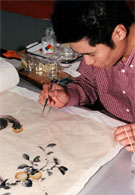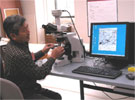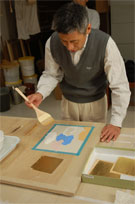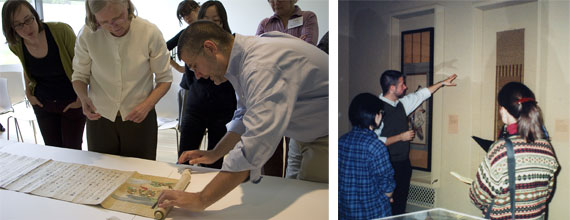
INTRODUCTION
HIRAYAMA IKUO
A survivor of the bombing at Hiroshima, Hirayama Ikuo (1930–2009) achieved renown as one of Japan’s most important artists of the twentieth century. Deeply aware of the importance of world culture and history, he was a philanthropist committed to the preservation of world heritage and, in particular, to Buddhist culture and historic monuments that were also the focus of his art. In 1988, he established the World Cultural Heritage Foundation. Hirayama served as the head of the Tokyo National University of Art and Music from 1989–95 and 2001–2005. His many honors and awards included the Legion d’honneur, the James Smithson award, and induction into the Order of Cultural Merit, Japan’s highest honor for achievement in the arts and sciences.
HISTORY OF THE PROGRAM
Hirayama proposed that the Japanese government and private organizations should undertake a project to assist in the care and preservation of Japanese art in Western collections. This led to the establishment of the Joint Council for the Conservation and Restoration of Ancient Japanese Art Works in Foreign Collections in 1991.That same year, the council signed an agreement with the Freer and Sackler Galleries to provide aid for the conservation of Japanese paintings in the Galleries’ collections. Over the following six years, approximately forty paintings from the Freer Gallery were conserved in Japan thanks to this support.
Following the success of this collaboration, Hirayama and the Freer and Sackler Galleries reached an agreement that created the Hirayama Program for Japanese Painting Conservation in 1999. It also endowed the program with a gift from the Foundation for Cultural Heritage and Art Research, over which Hirayama presided.
GOALS OF THE PROGRAM
The Hirayama Program is dedicated to advancing the state of conservation of Japanese paintings in the United States. The program has four main areas of activity:
- training Western candidates in the methods and principles of Japanese painting conservation
- supporting ongoing professional exchanges between the Freer and Sackler Galleries and conservation and research organizations in Japan
- conducting lectures and workshops on the care of Japanese paintings for staff of American museums that have East Asian painting collections but no specialists in this field
- conducting lectures and workshops on the physical nature and preservation of Japanese paintings to augment university courses and educational programs in East Asian art history.
PROGRAM ACTIVITIES
Hirayama Japanese Painting Conservation Fellowship 2023
The Smithsonian’s National Museum of Asian Art, Department of Conservation and Scientific Research, is pleased to announce the Hirayama Japanese Painting Conservation Fellowship. The fellowship is a full-time (40 hours/week) commitment awarded for one year with a possible extension for a second year. The fellowship carries a yearly stipend of $50,000 along with a yearly $4,000 travel/research allowance. Japanese language training may also be provided. The fellow will be required to maintain health insurance during the fellowship. The fellowship is expected to begin during the second half of 2023.
The fellow will train in the East Asian Painting Conservation Studio (EAPCS), studying the materials and methods of Japanese painting conservation and remounting. The fellowship cultivates practical skills and fosters a solid understanding of the cultural contexts of traditional mounting, conservation philosophy, and the ethics of the conservation profession in general.
The fellow will take part in EAPCS activities, including condition surveys, remedial treatment, and complete and partial remounting to help prepare collections for exhibit or loan. Conservation work may also include preventive conservation for storage and display as well as collaboration with other museum staff members. The fellow will participate in education and outreach activities and will produce outreach materials such as blogs, presentations, and articles.
Applicant Qualifications
Applicants should be recent graduates from a recognized conservation training program or have equivalent training and experience. The best qualified candidates are those interested in pursuing a conservation career specializing in Japanese painting conservation who have a proven record of interest in Japanese art, history, and culture and have English and Japanese language skills. Fellowships are awarded without regard to age, sex, race, or nationality of the applicant.
Deadline
Application must include a letter of interest, a CV/resume, a portfolio of conservation work (1–3 projects), and two letters of recommendation with contact information and must be submitted to dcsr@si.edu no later than March 31st, 2023.
Finalists will be invited to a virtual interview in April and will be asked to present conservation work from their portfolio. The final selection will be made in May.
For questions, please contact dcsr@si.edu.
LECTURES, WORKSHOPS AND PROFESSIONAL EXCHANGES

Exchanges of professional personnel between the Freer and Sackler Galleries and Japanese painting conservation studios, research centers, and university programs are undertaken to share expertise and broaden experience. Japanese conservation professionals stay in residence at the Department of Conservation and Scientific Research to work with staff conservators on various projects. East Asian Paintings Conservation Studio (EAPCS) conservators also have occasion to continue training in Japan. Experts also make shorter visits for research, lectures, or meetings.
VISITING PROFESSIONALS FROM JAPAN
Japanese painting conservators are invited for short-term study visits in the EAPCS, typically during the summer, for periods of several weeks to three months. Participants are encouraged to interact with members of the Freer and Sackler Galleries, various Western conservation centers, and other East Asian painting conservation studios in the United States.
Since 2004, five Japanese painting conservators have been chosen for their potential to benefit from exposure to Western conservation techniques and for their abilities to exchange ideas, build relationships, and share their experiences with other Japanese colleagues.
WORKSHOPS AND LECTURES ON THE MATERIALS AND METHODS OF JAPANESE PAINTING AND CONSERVATION

As part of the ongoing exchange of experts, Japanese conservators, scientists, and scholars are invited to the Freer and Sackler to present workshops and lectures related to Japanese painting conservation. These programs are intended for Western conservators and researchers who may work with East Asian collections, as well as for Japanese art historians and other specialists. These practical workshops create a forum for investigating traditional methods and materials, exchanging specialized knowledge, and advancing technical research about East Asian painting conservation while spreading this information to a broader audience.
The EAPCS staff facilitated the first technical workshop, “East Asian Paper Fiber Identification,” in 2005 and another four-day workshop, “Traditional Japanese Gold Decorating Techniques Used in Japanese Screen and Scroll Mounting,” in 2007. More recent lectures have covered topics including fiber analysis of traditional Japanese papers, historic Silk and Traditional Weaving Methods for Reproducing Brocade fabrics and alternative materials, and types of roller clamps for storing rolled formats. Information and photos from these proceedings are available here.
Please see our calendar of future events.

WORKSHOPS AND LECTURES ON THE CARE AND HANDLING OF EAST ASIAN SCROLLS AND SCREENS

Another important objective of the Hirayama Program is to provide information and training to help increase awareness and enhance the care of East Asian paintings in American collections. To encourage an active dialogue in the museum and scholarly communities about these concerns and help define practical solutions, members of the East Asian Painting Conservation Studio offer free lectures and workshops for the staff of American museums with holdings of East Asian paintings but no specialists in that area.
These educational sessions generally consist of a half-day to two-day program that provides hands-on practice of safe handling procedures for scrolls and screens, guidelines for safe storage and display of collections, or basic conservation and maintenance issues. Presentations about the physical nature of East Asian paintings, mounting formats, and their methods and materials are also offered. These lectures and workshops can be conducted at the Freer Gallery or in other museums with Asian collections, as well as in educational institutions with programs in Asian art history. Versions of these workshops are also given at the Freer and Sackler Galleries for staff, fellows, and interns each year.
For educational materials related to the care of East Asian painting collections, please see our archive.

LECTURES AND WORKSHOPS ON THE PHYSICAL NATURE AND PRESERVATION OF JAPANESE PAINTINGS TO AUGMENT UNIVERSITY COURSES AND EDUCATIONAL PROGRAMS IN EAST ASIAN ART HISTORY
In cooperation with Asian art history faculty at U.S. colleges and universities, “Care and Handling” workshops have been developed to acquaint art history students with the practical concerns of handling, storage, and display of East Asian paintings. These workshops are offered onsite as part of the art history coursework or can be coordinated with study visits to the Freer and Sackler Galleries.
Presentations about the physical nature of East Asian paintings, mounting formats, and their methods and materials are also offered. These lectures focus on specific aspects of Japanese paintings, such as characteristics of traditional pigments and painting supports, aesthetics and function of mounting formats, and the effects of conservation on the appearance of the image.
For information about the Hirayama Program, please e-mail dcsr@si.edu or call +1 (202) 633-0385
For educational materials related to the materials, methods, and care of East Asian painting collections, please see our online resources.







